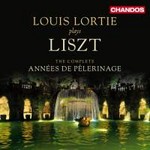
The complete Annees de Pelerinage
 $40.00
Out of Stock
$40.00
Out of Stock6+ weeks add to cart
LISZT
The complete Annees de Pelerinage
Louis Lortie (piano)
[ Chandos / 2 CD ]
Release Date: Monday 7 March 2011
This item is currently out of stock. It may take 6 or more weeks to obtain from when you place your order as this is a specialist product.
"Louis Lortie's survey of the complete Années de Pèlerinage adds up to his finest Liszt playing on disc. The interpretations abound with new-found reserves of virtuosic flair and poetic sensitivity. Strongly recommended."
(ClassicsToday June 2011)
"Louis Lortie's survey of the complete Années de Pèlerinage adds up to his finest Liszt playing on disc. The interpretations abound with new-found reserves of virtuosic flair and poetic sensitivity. You hear both of these qualities in the opening piece, La chapelle de Guillaume Tell, where Lortie varies the murmuring tremolo chords with subtle nuances yet doesn't hold back in the climactic Allegro vivace. You hear similar textural variety and heightened drama throughout Aux cypres de la Villa d'Este II.
In both Orage and the Dante sonata Lortie's superb technique enables him to articulate the long stretches of octaves in shapely legato lines that are executed with minimum pedal. This similarly applies to the ferocity and momentum Lortie generates in Vallée d'Obermann's peroration. Whereas pianists like Claudio Arrau and Muza Rubackyté take their time to savor Les jeux d'eau à la Villa d'Este's jet-spray arpeggiated figures, Lortie's comparable accuracy and finesse reveals them in a lighter, more playful manifestation. Lortie's well-judged tempo relationships create unity and momentum in Venezia e Napoli's Tarantella, but I prefer Marc-André Hamelin's almost offhanded panache and astounding repeated-note technique. While Chandos' slightly diffuse and distant sonics don't match Rubackyté's Lyrinx release for detail and warmth, they do reflect Lortie's robust sonority as one might experience it in a small concert hall. Strongly recommended."
(ClassicsToday June 2011)
The virtuoso pianist and exclusive Chandos artist Louis Lortie here performs all three books, or 'Years', of Liszt's Années de Pèlerinage (Years of Pilgrimage), a work rarely recorded in its entirety. Lortie has made more than thirty recordings for Chandos, covering a repertoire from Mozart to Stravinsky. His recording of Beethoven's 'Eroica' Variations won an Edison Award; his disc of works by Schumann and Brahms was judged one of the best CDs of the year by BBC Music, and his interpretations of Liszt's complete works for piano and orchestra and of Beethoven's complete piano sonatas were both selected as Editor's Choice in Gramophone.
Liszt was an artist by nature. He seemed to feel and be affected by external influences far more deeply than most, and he was a master at translating these feelings into music. The first Year of the Années de Pèlerinage, a reworking of pieces from his earlier Album d'un Voyageur, was inspired by his travels in Switzerland as a young man. In this work, the music does not depict or describe particular scenes or landscapes, rather it attempts to communicate the feeling that Liszt experienced when he saw them, his 'strongest sensations and most lively impressions'.
'Chapelle de Guillaume Tell', for example, depicts a fourteenth-century Swiss hero through a broad and stately theme that quotes a Swiss Alpine horn melody with trumpet calls, echoes, and tremolos. 'Au lac de Wallenstadt' depicts the gently rising and retreating waves of the lake, over which Liszt places a theme of beautiful simplicity.
The second Year was inspired by the art and literature that Liszt encountered on his travels in Italy. 'Sposalizio' was inspired by Raphael's painting The Marriage of the Virgin in the Brera in Milan, and 'Il Penseroso' by Michelangelo's statue on the tomb of Lorenzo de' Medici in the church of San Lorenzo in Florence.
The third and last Year of the Années de Pèlerinage was written much later, when Liszt was in his sixties, and at a time when both the man and the style of his music had undergone a vast change. The pieces show far more simplicity in the treatment of the musical components and often convey a mood of despair and stark austerity.
From the outset, Liszt knew that his Années de Pèlerinage was unlikely to appeal to the masses. In his own words, the work was 'written for the few rather than the many - not ambitious of success, but of the approval of that minority which conceives art as having other uses than the beguiling of idle hours, and asks more from it than the futile distraction of a passing entertainment'.
Tracks:
Années de pèlerinage, 1ère année, Suisse (9 pieces), S. 160
Années de pèlerinage, 2ème année, Italie (7 pieces), S. 161
Années de pèlerinage, 3ème année (7 pieces), S. 163
Venezia e Napoli (3 pieces), S. 162